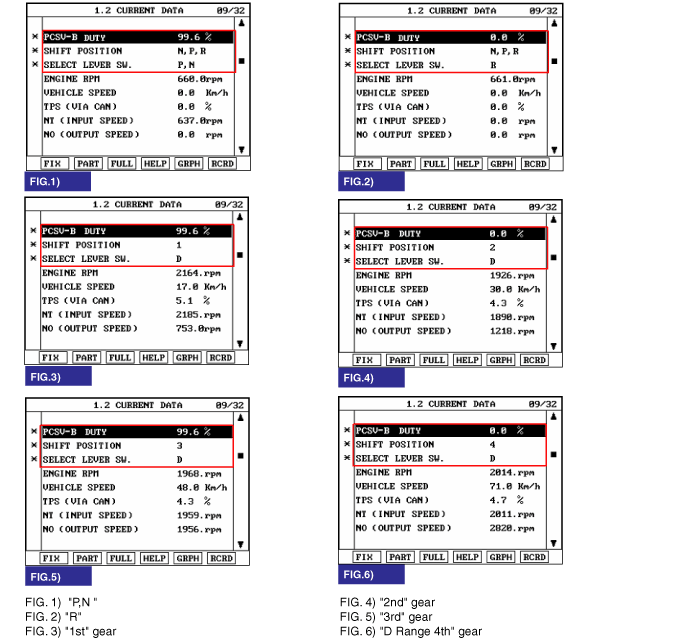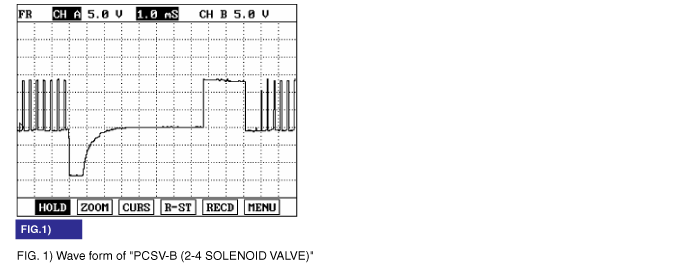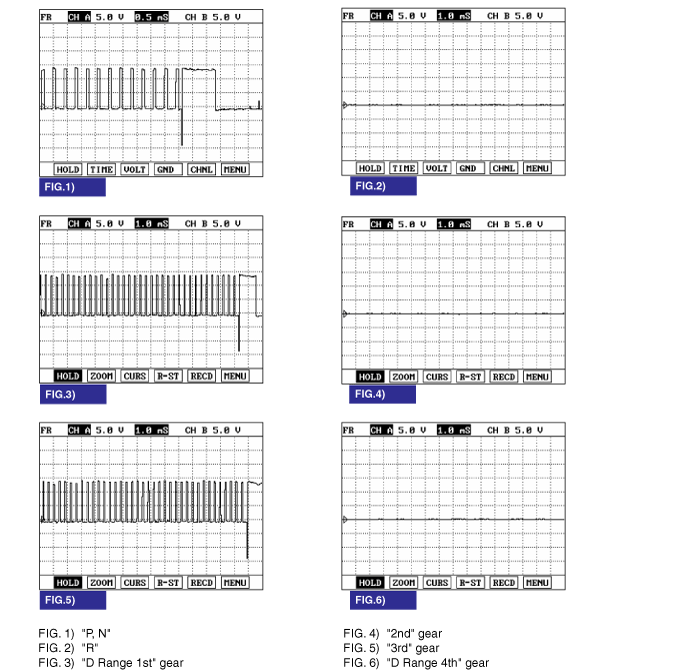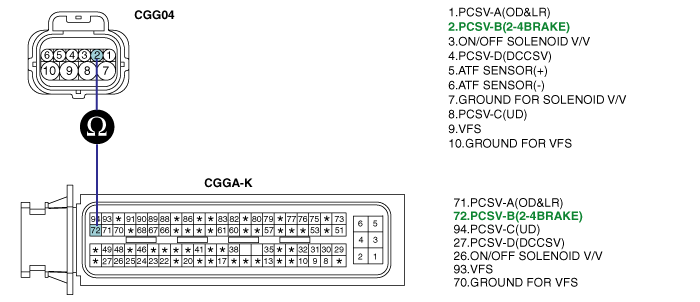Shift gear at each position.


The Automatic transmission changes the gear position of the transmission by utilizing a combination of clutches and brakes, which are controlled by solenoid valves. This HIVEC automatic transmission consists of a: LR (Low and Reverse Brake), 2ND (2nd Brake), UD (Under Drive Clutch), OD (Over Drive Clutch).
The PCM/TCM checks the 2nd brake drive control signal by monitoring the feedback signal from the solenoid valve drive circuit. If an unexpected signal is monitored, (For example, high voltage is detected when low voltage is expected or low voltage is detected when high voltage is expected) the PCM/TCM judges that 2nd Brake drive control solenoid circuit is malfunctioning and sets this code.
Item | Detecting Condition | Possible cause |
DTC Strategy | ● Check voltage range | ● Open or short in circuit ● Faulty 2-4 SOLENOID VALVE ● Faulty PCM/TCM |
Enable Conditions | ● 16V > Actuator(TCU) power supply voltage >10V | |
Threshold value | ● Circuit open or short to ground | |
Diagnostic Time | ● More than 1 sec | |
Fail Safe | ● Locked in 3rd gear |

Solenoid Valve for Pressure Control
Sensor type : Normal open 3-way
Operating temperature : -30°C~130°C(-22~266°F)
Frequency :
- PCSV-A,B,C,D : 50Hz (at the ATF temp. -20°C above) - VFS : 400~1000 ※ KM series : 35Hz |
Internal resistance :
- Internal resistance : 3.5 ± 0.2Ω(20°C or 68°F) |
Surge voltage : 56 V
Connect scantool to data link connector(DLC).
Engine "ON".
Monitor the "PCSV-B(2-4 SOLENOID VALVE)" parameter on the scantool.
Shift gear at each position.

Does "PCSV-B(2-4SOLENOID VALVE)" follow the reference data?

▶ Fault is intermittent caused by poor contact in the sensor's and/or TCM(PCM)'s connector or was repaired and TCM(PCM) memory was not cleared. Thoroughly check connectors for looseness, poor connection, bending, corrosion, contamination, deterioration or damage. Repair or replace as necessary and go to "Verification of vehicle repair" procedure.

▶ Go to "Terminal&connector inspection " procedure.
Many malfunctions in the electrical system are caused by poor harness and terminals. Faults can also be caused by interference from other electrical systems, and mechanical or chemical damage.
Thoroughly check connectors for looseness, poor connection, bending, corrosion, contamination, deterioration, or damage.
Has a problem been found?

▶ Repair as necessary and then go to "Verification of vehicle repair" procedure.

▶ Go to "Power supply circuit inspection" procedure.
Connect "A/T SOLENOID VALVE" connector and install device for measuring wave form.
Turn on the Engine and operate PCSV-B(2-4 SOLENOID VALVE).
Measure wave form between terminal "2" of the sensor harness connector and chassis ground.


Is measured normally operating wave form?

▶ Go to "Signal circuit inspection" procedure.

▶ Check for open in harness. Repair as necessary and go to "Verification of vehicle repair" procedure.
Check signal circuit open inspection
Ignition "OFF".
Disconnect "A/T SOLENOID VALVE" connector and "PCM/TCM" connector.
Measure resistance between terminal "2" of the ATM SOLENOID VALVE harness connector and terminal "72" of the PCM/TCM harness connector.
Specification: approx. 0 Ω

Is resistance within specifications?

▶ Go to "Check signal circuit short inspection" procedure.

▶ Check for open in harness. Repair as necessary and go to "Verification of vehicle repair" procedure.
Check signal circuit short inspection
Ignition "OFF".
Disconnect "A/T SOLENOID VALVE" connector and "PCM/TCM" connector.
Measure resistance between terminal "2" of the ATM SOLENOID VALVE harness and chassis ground.
Specification: Infinite

Is resistance within specifications?

▶ Go to "signal circuit ground inspection" procedure.

▶ Check for short to ground in harness. Repair as necessary and go to "Verification of vehicle repair" procedure.
Check signal circuit ground inspection
Ignition "OFF".
Disconnect "A/T SOLENOID VALVE" connector and "PCM/TCM" connector.
Measure resistance between terminal "7" of the ATM SOLENOID VALVE harness and chassis ground.
Specification: approx. 0Ω

Is resistance within specifications?

▶ Go to "Component Inspection" procedure.

▶ Check for short to ground in harness. Repair as necessary and Go to "Verification of vehicle repair" procedure.
CHECK SOLENOID VALVE
Ignition "OFF".
Disconnect "A/T SOLENOID VALVE" connector.
Measure resistance between terminal "2" and terminal "7" of the ATM SOLENOID VALVE harness connector.
Specification: Approximately 3.5±0.2Ω [(25°C(77°F)]

Is resistance within specification?

▶ Go to "CHECK PCM/TCM" as below.

▶ Replace PCSV-B(2-4 SOLENOID VALVE) as necessary and go to "Verification of Vehicle Repair" procedure.
CHECK PCM/TCM
Connect scantool to data link connector(DLC).
Ignition "ON" & Engine "OFF".
Select A/T solenoid valve actuator test and operate actuator test.
Is Actuator Testing performed normally?


▶ Go to "Verification of vehicle repair" procedure.

▶ Replace PCM/TCM as necessary and go to "Verification of vehicle repair" procedure.
ACTUATOR TEST CONDITION
IG SWITCH ON
TRANSAXLE RANGE SWITCH is normal
P RANGE
Vehicle Speed 0mph(0km/h)
Throttle position sensor < 1V
IDLE SWITCH ON
ENGINE RPM 0
After a repair, it is essential to verify that the fault has been corrected.
Connect scantool and select "Diagnostic Trouble Codes(DTCs)" mode.
Using a scantool, Clear DTC.
Operate the vehicle within DTC Enable conditions in General information.
Are any DTCs present ?

▶ Go to the applicable troubleshooting procedure.

▶ System performing to specification at this time.